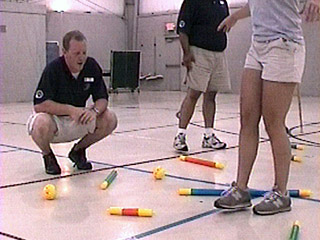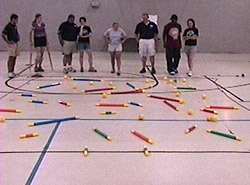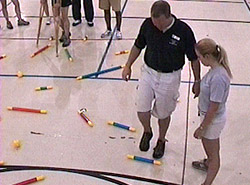Activity 13: Minefield



Minefield Activity
Activity Plan
Group Size: 4 - 30
Time: 25 - 45 minutes
Mental Intensity: 2
Physical Intensity: 1
Space: Lots
Objectives
- Brainstorm and share communication strategies to guide a partner in the minefield
- To provide suggestions and listen to ideas about traveling through the minefield
- Rely on others to get through the maze
- Discuss the experience and their feelings
Character Focus
Trust & Perseverance
Preparation
Time: 5 minutes
Materials:
1 Toobeez set
70 feet of rope
1 envelope
chart paper (optional)
Setup:
- Place the Risk Taking Note into an envelope.
- Outline an area with the rope to create a playing area. Make the edges “wavy” to prevent the participants from following the edge of the rope as a potential path.
- Spread out all 52 Toobeez pieces inside the roped area.
The Challenge
Help your partner successfully travel from one end of the minefield to the other
Special note: This game was taught to the author by Jeff Long, and it was written up by Karl Rohnke in “Quicksilver,” published in 1995.
Safety Reminders!
Appropriate caution is important to conduct these activities in a safe manner. Be sure to review these reminders prior to beginning the activity, and if necessary, share reminders with the group during the activity.
- Follow general safety procedures
- Some people lose their balance when their eyes are closed. If someone begins to lose their balance they should open their eyes
Helpful hints
- During the actual activity, you may find the group has located an “easy” pathway. Allow yourself the option as the facilitator to adjust the minefield playing area midstream by rearranging the Toobeez pieces. If the group challenges this, remind them you’re attempting to mimic real life (that is, things change and you deal with it)
- The great thing about this activity is people work in pairs and are somewhat independent of the other people
- This is a wonderful activity to practice coaching as every moment of this activity provides ample opportunity to practice clear and precise communication
Activity Instructions
- Circle up the group. Distribute or display the appropriate “Risk Taking Note” for the activity. Have one participant read it aloud twice. Provide a few moments for the participants to think about the message:
“Never doubt that a small group of thoughtful committed citizens can change the world. Indeed, it is the only thing that ever has.” - Margaret Mead - Share the following storyline with group.
You are working to help find a clear path for people to walk through so that they can get to safety. Together you can find it! - Read aloud the following Activity Challenge Box to the group.
Challenge: Help your partner successfully travel from one end of the minefield to the other. Follow the guidelines below:- When one partner is inside the minefield, the other must remain on the outside
- People traveling through the minefield must keep their eyes closed and may not be guided through with the use of anything (i.e. no holding hands, etc.)
- If anyone touches a landmine or the rope perimeter, they must return to the starting area and switch with their partner
- The participants may not alter the playing area
- If any guidelines are broken, the group must begin again
- Before the participants attempt an activity challenge, have the group work through the following six steps:
- Circle up
- Know and understand the challenge and the guidelines
- Brainstorm
- Make a plan
- Do the plan
- Evaluate results and adjust as necessary
- When ready to begin, the group must start at the designated starting area (one end of the rope rectangle). Each pair will then work through the minefield.
- Be sure to monitor the group for safety as they attempt the activity.
- If participants get stuck, have the students circle up again. Here are some suggested questions to help guide the group back on track*:
- What is working?
- What ideas have you not tried yet that someone suggested?
- If your group is still struggling OR if you feel your group would benefit from an additional challenge, present a variation provided on the next page.
- After the activity, move to the debriefing questions for discussion.


Problem Solving Sequence:
Activity Variations
- Adding obstacles.
Consider making “3-D” obstacles out of the Toobeez (rather than laying them all flat on the ground). This way team members traveling through the minefield will have to step over some things. - Create Goal Cards
On index cards, have participants write down goals. These cards can be used as the objects this group retrieves from the other end of the minefield. - Take away verbal communication.
Do not allow participants to use verbal communication to work through the mines.
Debriefing the Activity
Use these debriefing questions as a guide for your discussion. Select the questions you feel will best benefit your group. It is not mandatory to cover every question. If possible, record the group’s responses on flip chart paper so all comments are displayed. Make sure to let everyone share their ideas, and remind participants that everyone’s opinions and feelings are important!
Base questions for debriefing:
- How did you feel while you did the activity?
- Discussion point: Landmines are metaphoric problems the group faces either personally or as a team. They are everywhere in life (personal & public). Some landmines are big and some are small, but hey all do damage when we hit them. What are the landmines in your life that you are choosing to avoid?
- We can go through life trying to avoid obstacles, but it’s easier when we have help. Where do you get help in real life? Are you effective at asking for help? Are you good at accepting/giving help? How do you know?
If the group was unable to complete the task in the given time:
- Why do you think it was so difficult to make it through the minefield?
- Since you were not able to solve the problem, does it mean your group is a failure? (Push the group to respond with more than a “yes” or “no” and to instead point out and discuss what they learned.)
Additional questions: Choose which ones are the most appropriate:
- What was one of the challenges of doing this activity?
- How did clear communication help you and your group during this activity?
Close on a Positive Note
Sum up the different ideas and feelings that you heard expressed, and restate ideas and learning moments the participants shared. Then, read the Risk Taking Note out loud again, and ask people to discuss what they think this note means. Discuss what they thought it meant at the beginning and what they think it means now.
* (ˆ) Do not provide the participants with answers. Allow them to work together.





